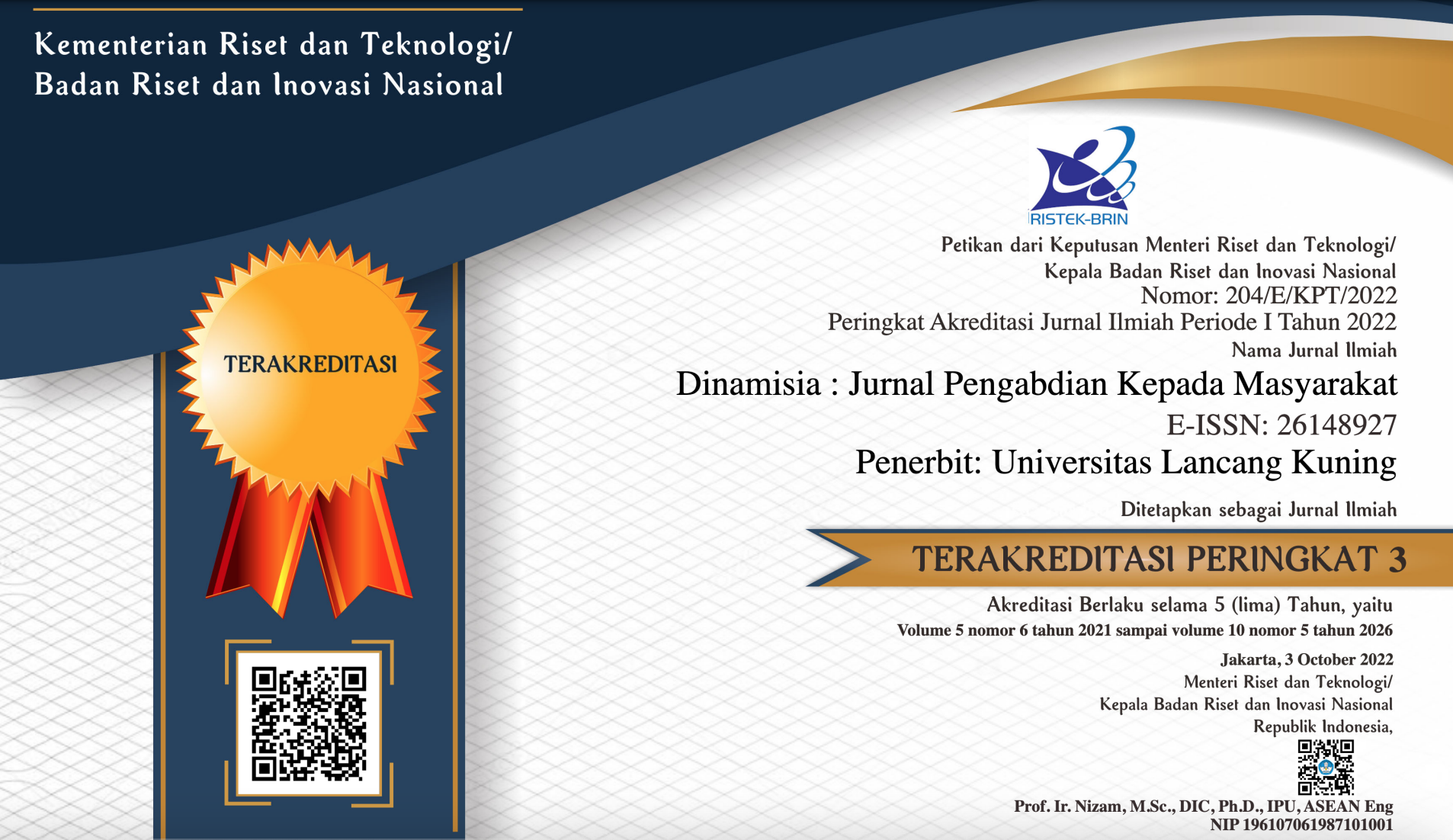Community Partnership Empowerment Through Utilizing Waste Glass for Construction Products
Pemberdayaan Kemitraan Masyarakat Melalui Pemanfaatan Limbah Kaca Menjadi Produk Konstruksi
Abstract
Waste glass constitutes significant landfill waste, leading to environmental concerns. Considering its chemical composition, glass powder contains 50% to 60% silica, making it suitable for construction materials. Consequently, this community service initiative introduced waste glass as a building material, serving as a partial substitute for sand in construction products. In addition, the activity involved teaching partners how to create castings/road gates utilizing waste glass. The target partners in this activity were productive business groups engaged in selling wind holes, well rings, rosters, and similar products. The approach applied involved socialization and hands-on practices at the partner's premises. The program's success was obtained through interviews and product compressive strength tests with the partners. The outcomes demonstrate the partners' keen interest in the activity, their understanding of the benefits of utilizing waste glass as a partial sand replacement, and their ability to create products. Notably, the compressive strength of the products created with the partners ranged from 24.72 MPa to 30.84 MPa, aligning with the SNI 03-2442-1991 standard for road curbs (30 MPa). The activity positively impacted the partners, enhancing their business prospects and contributing to environmental sustainability. The training helps in enhancing the partners' skills and capabilities.
Downloads
References
Ahmad, J., Majdi, A., Deifalla, A. F., Isleem, H. F., & Rahmawati, C. (2022). Concrete Made with Partially Substitutions of Copper Slag (CPS): State of the Art Review. Materials, 15(15), 1–28. https://doi.org/https://doi.org/10.3390/ma15155196
Aliabdo, A. A., Elmoaty, A. E. M. A., & Y.Aboshama, A. (2016). Utilization of waste glass powder in the production of cement and concrete. Construction and Building Materials, 124, 866–877. https://doi.org/https://doi.org/10.1016/j.conbuildmat.2016.08.016
Borek, K., & Czapik, P. (2022). Utilization of Waste Glass in Autoclaved Silica–Lime Materials. Materials, 15(2), 1–14. https://doi.org/https://doi.org/10.3390/ma15020549
Elaqra, H. A., Haloub, M. A. A., & Rustom, R. N. (2019). Effect of new mixing method of glass powder as cement replacement on mechanical behavior of concrete. Construction and Building Materials, 203, 75–82. https://doi.org/https://doi.org/10.1016/j.conbuildmat.2019.01.077
Hama, S. M., Mahmoud, A. S., & Yassen, M. M. (2019). Flexural behavior of reinforced concrete beam incorporating waste glass powder. Structures, 20, 510–518. https://doi.org/https://doi.org/10.1016/j.istruc.2019.05.012
Handayani, L., Aprilia, S., Abdullah, A., & Rahmawati, C. (2020). Synthesis of sodium silicate from rice husk ash as an activator to produce epoxy-geopolymer cements. International Conference on Industrial Automation, Smart Grid and Its Application.
Handayani, L., Aprilia, S., Abdullah, A., Rahmawati, C., Aulia, T. B., Ludvig, P., & Ahmad, J. (2022). Sodium Silicate from Rice Husk Ash and Their Effects as Geopolymer Cement. Polymers, 14(14), 1–14. https://doi.org/https://doi.org/10.3390/polym14142920
Jubeh, A. I., Saffar, D. M. Al, & Tayeh, B. (2019). Effect of recycled glass powder on properties of cementitious materials contains styrene butadiene rubber. Arabian Journal of Geosciences, 12(2). https://doi.org/10.1007/s12517-018-4212-0
Li, Q., Qiao, H., Li, A., & Li, G. (2022). Performance of waste glass powder as a pozzolanic material in blended cement mortar. Construction and Building Materials, 324, 126531. https://doi.org/https://doi.org/10.1016/j.conbuildmat.2022.126531
Manikandan, P., & Vasugi, V. (2021). A Critical Review of Waste Glass Powder as an Aluminosilicate Source Material for Sustainable Geopolymer Concrete Production. Silicon, 13(10), 3649–3663. https://doi.org/10.1007/s12633-020-00929-w
Patel, D., Tiwari, R. P., Shrivastava, R., & Yadav, R. K. (2019). Effective utilization of waste glass powder as the substitution of cement in making paste and mortar. Construction and Building Materials, 199, 406–415. https://doi.org/https://doi.org/10.1016/j.conbuildmat.2018.12.017
Rahmawati, C. (2023). Enhancing Industrial Production Quality Through Innovations and System Improvements in Paving Block Manufacturing. DINAMISIA: Jurnal Pengabdian Kepada Masyarakat, 7(3), 781–788.
Rahmawati, C., Amin, A., Meutia, P. D., Meliyana, M., Zardi, M., Syahputra, I., Sriana, T., Putri, L. D., & Khalis, M. (2022). Pengenalan dan Pemanfaatan Limbah Kaca Menjadi Produk Bernilai. DINAMISIA: Jurnal Pengabdian Kepada Masyarakat, 6(5), 1379–1386.
Rahmawati, C., Aprilia, S., Saidi, T., Aulia, T. B., Amin, A., Ahmad, J., & Isleem, H. F. (2022). Mechanical Properties and Fracture Parameters of Geopolymers based on Cellulose Nanocrystals from Typha sp. Fibers. Case Studies in Construction Materials, e01498. https://doi.org/https://doi.org/10.1016/j.cscm.2022.e01498
Rahmawati, C., Muhtadin, M., Faisal, M., Iqbal, I., Zardi, M., Meliyana, M., & Nasruddin, N. (2022). Teaching industry: Pengolahan Limbah Kaca Menjadi Produk Konstruksi. Jurnal Vokasi, 6(2), 112–119.
Shoaei, P., Ameri, F., Musaeei, H. R., Ghasemi, T., & Ban, C. C. (2020). Glass powder as a partial precursor in Portland cement and alkali-activated slag mortar: A comprehensive comparative study. Construction and Building Materials, 251, 118991. https://doi.org/https://doi.org/10.1016/j.conbuildmat.2020.118991
Siddika, A., Hajimohammadi, A., Mamun, M. A. Al, Alyousef, R., & Ferdous, W. (2021). Waste Glass in Cement and Geopolymer Concretes: A Review on Durability and Challenges. Polymers, 13(13), 2–26. https://doi.org/https://doi.org/10.3390/polym13132071
Tamanna, N., Tuladhar, R., & Sivakugan, N. (2020). Performance of recycled waste glass sand as partial replacement of sand in concrete. Construction and Building Materials, 239, 117804. https://doi.org/https://doi.org/10.1016/j.conbuildmat.2019.117804
Xiao, R., Ma, Y., Jiang, X., Zhang, M., Zhang, Y., Wang, Y., Huang, B., & QiangHe. (2020). Strength, microstructure, efflorescence behavior and environmental impacts of waste glass geopolymers cured at ambient temperature. Journal of Cleaner Production, 252, 119610. https://doi.org/https://doi.org/10.1016/j.jclepro.2019.119610


















